Behind Gree Midea’s Fighting from a Distance: Detonating the Old Enemy’s Old Account of New Chou He
Original Wei Shiwei intelligent things
Aspect: Gree’s "China Mobile Bidding" War! When will prices, patents, and talents dig corners, and when will they be avenged for ten years?
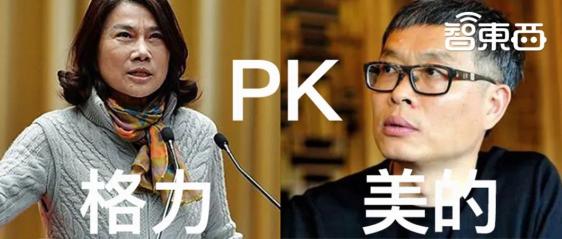

On July 7th, Gree Electric and Chongqing Midea issued announcements one after another last night, questioning and clarifying their "fraud" behavior in the bidding process of China Mobile.
Gree took the lead in publishing "Who is practicing fraud in mobile bidding projects?" at 11: 21 yesterday. "Open letter" refers to the fact that Midea is inconsistent with the facts in the mobile bidding project. Nearly eight and a half hours later, Midea released the Clarification on Invoice Information and Technical Parameters of China Mobile Project, responding to Gree’s query.
Since China Mobile Purchasing and Bidding Network released the Announcement on the Handling Results of Negative Behavior of Zhuhai Gree Electric Co., Ltd. on June 1st, the incidents of "fraud" between Gree and Midea around the procurement projects of both parties have continued to ferment.
Wisdom systematically combed the incident of Gree and Midea, and refined two important time nodes: First, China Mobile disclosed Gree’s "fraud", and Gree responded that the confrontation between the two sides was ready; Second, Gree directly named the surname and questioned the beauty, and the response of the beauty pushed the battle between the two sides to a climax.
Who is right or wrong in this bidding "tearing" war? As the two giants in the field of household appliances in China, the recent bidding events of two major manufacturers are only an opening to make the competition contradictions between the two sides public.
In fact, there has never been a shortage of quarrels between Gree and Midea in terms of market, patents and talents, especially in the two most important HVAC markets. Gree Midea’s revenge has never stopped.

China Mobile disclosed Gree’s "falsification" announcement, and Gree stated its response.
The source of this incident should start from June this year.
On June 1st, China Mobile announced that Gree Electric had cheated in the centralized procurement project of high-pressure centrifugal chillers in China Mobile from 2020 to 2021, and decided to cancel Gree Electric’s bid-winning qualification, and deducted 5 points from the comprehensive evaluation score of centralized procurement of high-pressure chillers, low-pressure chillers and other similar products that Gree participated in in in the next three years.
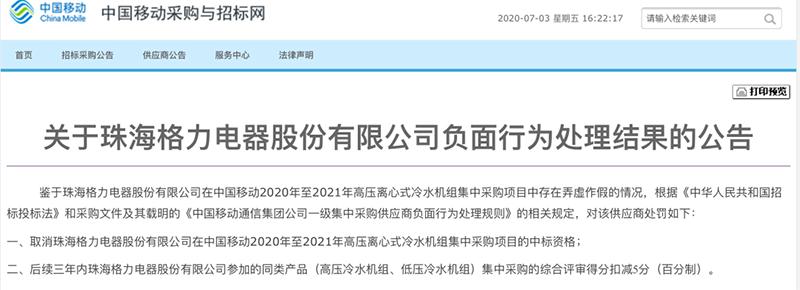
This means that China Mobile’s two bidding packages with a project scale of about 400 million RMB will all be won by competitor Midea, and at the same time, the "starting line" of bidding scores in the next three years will be 5 points behind.
In fact, this announcement did not immediately attract widespread attention. It wasn’t until January of July that relevant media began to report on this bulletin. The remarks of "Gree’s false standard" were frequent, and the whole home appliance market exploded and became increasingly fierce on the Internet. The rapid fermentation of the news of "false standard" attracted Gree’s attention.
Time advanced to July 4, and Gree finally couldn’t help it. He directly issued a statement to clarify "Shouting".
Gree claimed that a large number of news about Gree’s "fraud" in the bidding was untrue, and explained that the "fraud" mentioned in China Mobile’s bulletin was mainly due to material arrangement errors.
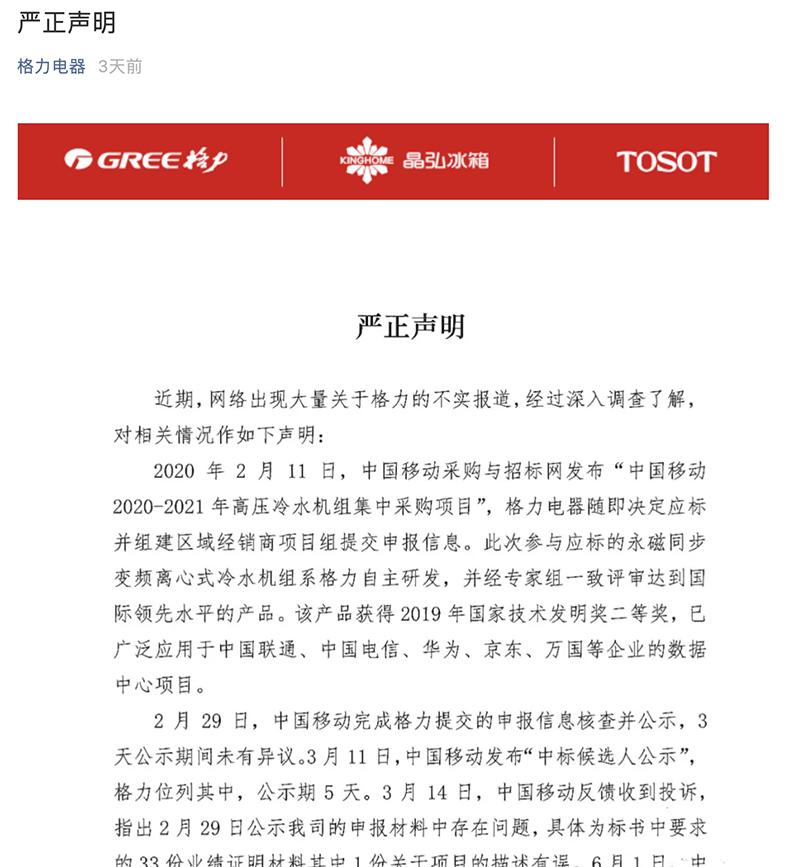
The specific mistake is that the bidders of Gree regional distributor project team sorted out and declared "Huawei Tuanbowa No.8 plot industrial project (Phase I)" won by Gree as "Huawei Tuanbowa No.8 plot industrial IDC project (Phase I)" when submitting the application performance certification materials.
In other words, the material errors of these two projects with only the difference of "IDC" directly made Gree miss the bid package that was about to come to hand. And is this really a material error, or is it intentional? We don’t know yet.
In response to this work mistake, Gree said that the responsible person has been seriously dealt with. At the same time, Gree also specifically mentioned in the announcement that its investigation found that the remarks and behaviors of malicious slander attacks on Gree on the Internet were "made by a certain peer company in Guangdong" and it will reserve the right to pursue its legal responsibility.
Although Gree didn’t explicitly point out who "a certain peer company in Guangdong did", it was also obvious that it was going to throw this "pot" to Midea Company headquartered in Foshan, Guangdong.
At this point, the conflict between Gree and Midea has not been directly put on the table, and the two sides still remain calm, but the undercurrent under the table is ready to move.

Gree followed closely the "falsification" of the disclosure of beauty, and the clarification response of beauty.
The first round of "war" came to an end, but only two days later, Gree once again "raised his gun".
On July 6th, Gree rushed to release "Who is practicing fraud in the mobile bidding project?"? "open letter, began to dig up the old accounts of the United States. Gree mentioned in an open letter that there were two "fraudulent" behaviors in the early stage of Midea’s bidding for China Mobile.
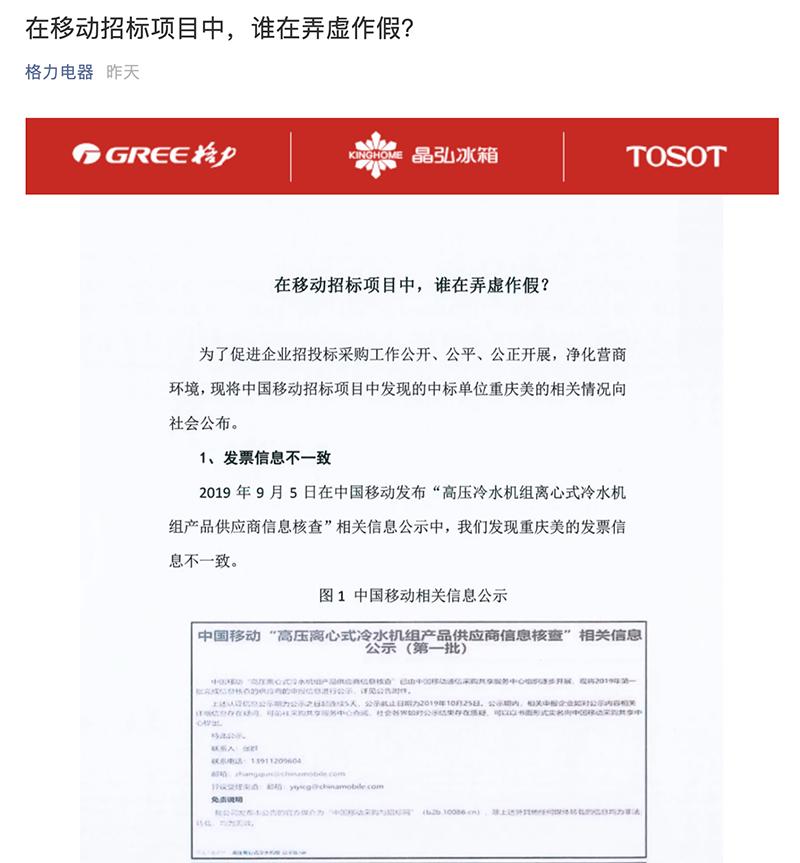
One is "Inconsistent invoice information". Gree said that it found that the invoice information provided by Midea was inconsistent in the information disclosure of "Information Verification of Centrifugal Chillers for High-pressure Chillers" issued by China Mobile on September 5, 2019, and it was inquired in the State Taxation Bureau that "there is no such invoice".
Second, "technical parameters do not meet the bidding standards". Gree pointed out that the early China Mobile bidding "2017-2018 Centralized Procurement Project of High-pressure Centrifugal Chillers" required 2500RT of bidding cooling capacity, but at that time Gree found that the maximum cooling capacity certification of Chongqing Midea AHRI Laboratory was 2200RT, which did not meet the bidding requirements.
Gree found through inquiry that as of February 26th this year, the AHRI official website of Midea did not show the relevant test-bed certificate of China Mobile’s bidding project, and it was not until the end of March that the 3000RT test-bed certificate was added.
In response to the above two questions, Gree said that he had made many feedbacks to China Mobile, but judging from the results, Chongqing Midea not only won the bid many times, but even won the bid only many times.
After this open letter, Gree not only turned the finger of "fraud" to the United States, but also questioned the bidding review of China Mobile from the side.
Eight and a half hours after Gree’s open letter was released, Midea quickly released the Clarification Notes on Invoice Information and Technical Parameters of China Mobile Project in the official Weibo at 19: 51 on the same day, which officially responded to this matter for the first time and for the "last time", directly pushing the debate between the two sides to a climax.
In this note, Midea pointed out that Gree’s doubts about China Mobile’s bidding project were "not true", and said that "the Qing Dynasty cleared itself", and the relevant evidence had already been clarified to China Mobile during the bidding process.

Regarding Gree’s point that the invoice information is inconsistent, Midea’s statement is that the project team members made a clerical error when manually filling in the invoice number, and the original invoice has passed the audit of the on-site auditors at the supplier qualification audit meeting.
As for the problem that Gree pointed out that the technical parameters did not meet the bidding standards, Midea disclosed the relevant AHRI certification and third-party testing report, but did not directly explain why it "failed to meet the bidding requirements" at the time of bidding, and it was not until this year that relevant technical certificates were added.

At this point, we can see that Gree has always taken Gree Electric and Dong Mingzhu from the media as its own positions, and successively exported to Midea and China Mobile, while Midea only responded once in the Weibo account in official website, which seems to be comfortable.
China Mobile, the tenderer of this "debate" between the two sides, has not yet responded to this incident.

Gree’s beauty has been contending for more than ten years.
Gree and Midea are not the first time to provoke a war in the air-conditioning market, among which HVAC is the most important battlefield in the long-term game between the two sides.
It is understood that in 2019, Gree’s main business air conditioning revenue was 138.665 billion yuan, accounting for 69.98% of the total revenue; Midea’s main business HVAC revenue was 119.607 billion RMB, accounting for 42.99% of the total revenue.
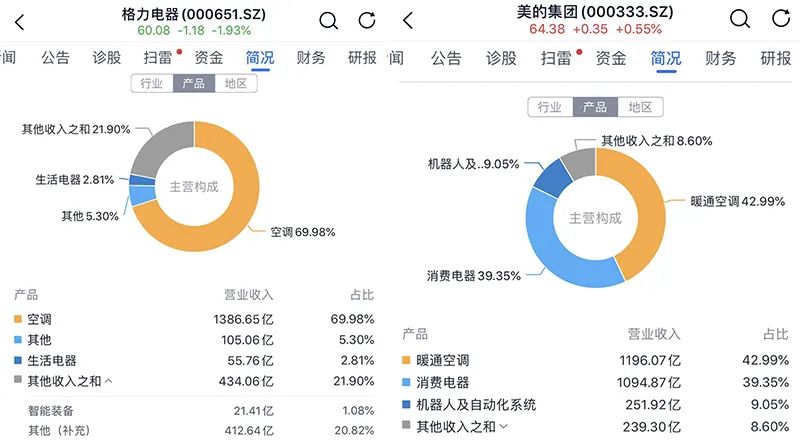
Gree and Midea’s wolf smoke are not only ignited in the HVAC market.
According to the report of State Grid, as early as 2009, Gree and Midea had already started a "price war" on air conditioners, from 6.8% discount to 6.5% discount, from "unconditional return of some air conditioners" to sending 100 yuan coupons, and the battle between Gree and Midea around the air conditioner market became more and more fierce.
In addition to the price war, the "struggle" between Gree and Midea is also reflected in technology, talents and patents, which directly leads to the contradiction rising to the situation that the leading bodies tear each other.
In 2015, Dong Mingzhu spoke publicly at the Zhuhai Industrial Transformation Work Conference. In order to obtain Gree’s air conditioning technology, in 2014, "a well-known domestic enterprise" not only tried to recruit Gree’s technical talents, but also brazenly set up the office responsible for poaching outside several bus stops at Gree’s headquarters.
Speaking of this poaching incident, Dong Mingzhu said that "Gree Electric sent someone to beat the other side".

▲ Dong Mingzhu, Chairman of Zhuhai Gree Electric Co., Ltd.
In response to Gree’s "beating", Fang Hongbo, a professional manager of Midea at that time, once responded stubbornly, "Everyone who comes out of Gree will not need beauty".

▲ Fang Hongbo, Chairman and President of Midea Group Co., Ltd.
In addition, from 2008 to 2017, Gree has repeatedly sued the United States around air-conditioning functions, patents and trademarks. Among them, in June 2017, Gree filed a lawsuit in the court, infringing on Gree’s "Refrigeration King" series of air conditioners, infringing Gree’s utility model patent right, and claiming 50 million yuan.
Midea is not idle. After Gree won the case, Midea initiated four lawsuits in Suzhou, Guangzhou and other places, claiming that Gree infringed on its invention patents and utility model patents, and the accumulated claims exceeded 50 million yuan.
Interestingly, in addition to price wars, technology poaching and patent wars, Gree and Midea also "burned" the war into their respective financial reports. Both of them claimed that their central air-conditioning market share was "the first in the market" in the 2019 annual report, and each was king.
It is understood that Gree’s revenue in 2019 was 198.153 billion yuan, a year-on-year increase of 0.02%; The net profit was 24.672 billion yuan, down 5.84% year-on-year. Midea’s revenue in 2019 was 278.216 billion yuan, a year-on-year increase of 7.14%; The net profit was 24.211 billion yuan, a year-on-year increase of 19.68%.

Air-conditioning market crisis behind the mutual tearing war
Behind the tearing war between Gree and Midea, it also reflects that China’s central air-conditioning market has entered a stage of weak development.
Dong Mingzhu publicly said in March this year that Gree’s revenue loss in February this year was as high as 20 billion due to the novel coronavirus epidemic.
We set our eyes on the whole industry. According to the latest data of "Mechanical and Electrical Information Central Air Conditioning Market" published by Mechanical and Electrical Information Magazine, the central air conditioning market in China experienced an annual negative growth for the first time in 2019, and the market showed a sluggish trend in all four quarters, with a year-on-year decline of 3.61%.
This also means that the general trend of continuous growth of China’s central air-conditioning market for many years has gone, and the market winter has arrived.
At the same time, under the influence of Sino-US trade friction, real estate extrusion and the slowdown of macro-economic growth, the central air-conditioning industry has gradually changed from the initial incremental market to the stock market. In addition, the novel coronavirus epidemic has worsened this year, and the market challenges faced by home appliance companies such as Gree and Midea are even more severe.
Under the cover of the cold winter in the whole air-conditioning market, how to seize more market share in the stock market has also become a vital event for all enterprises.
Faced with the concerns about the development of the whole central air-conditioning industry, the "fraud" war fought by Gree and Midea around the bidding of China Mobile is undoubtedly a microcosm of air-conditioning players speeding up fierce fighting and grabbing the market for survival.

Conclusion: the battle for survival of home appliance giants in the cold winter of the market
From the initial price war, patent war, talent grabbing, to today’s bidding competition, Gree and Midea’s air-conditioning market, which is the "enemy", has gradually entered a new turning point.
Under the new industry trend, grabbing more market share in the stock market is undoubtedly an important means to stabilize the position of their respective industries, but what is more important is not only to stabilize the market "throne", but how to seize the opportunity of the times and continuously add value to enterprises through technical means in the environment where technologies such as AI, 5G and Internet of Things are gradually maturing. This is the best way to gain a foothold in the market for a long time.
(This article is the original content of the signing account of Netease News Netease Special Content Incentive Plan [Zhizhi]. It is forbidden to reprint it at will without the authorization of the account. )

Original title: "Behind Gree’s beauty! Detonating old rivals’ old scores of new Chou He.


























